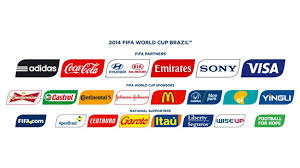July 25 – A newly published survey of UK, US and Brazilian consumers finds that Coca-Cola, McDonald’s, Visa and Adidas were the most recognised sponsors of the World Cup in Brazil, achieving recognition among 50%, 39%, 41% and 36% respectively, amongst UK, US and Brazilian consumers.
The report, from GlobalWebIndex, finds that 30% of those surveyed thought non-sponsor Nike was officially associated with the event, with similar levels of misplaced recognition for MasterCard (25%) and Samsung (20%).
Jason Mander, GlobalWebIndex’s Head of Trends, commented on the survey findings: “Real-time, ambush, content and football-related marketing meant a wealth of content-spread across the globe and significantly influenced spectators’ brand awareness and reactions.
“Consequently, it became more difficult for consumers to differentiate between official sponsors and competitors. Interestingly though, it seems that overall sponsorship recognition comes from long-term associations, which ultimately defies the intense marketing efforts made this year.”
During the FIFA World Cup, GlobalWebIndex surveyed people who were watching the competition in the UK, USA and Brazil, both before and after the tournament, to track their awareness levels in terms of the tournament’s official sponsors.
The survey results include that:
• The value of being an official partner is demonstrated by the sponsors in each sector outperforming all of their competitors – often by a ratio of 2:1 or more. Most sponsors also recorded very small to modest rises in recognition over the duration of the competition, although this was driven by Brazil rather than the UK and USA (where some recognition levels actually decreased slightly due to the confusion caused by ambush marketing).
• Overall, no official partner brand increased its recognition by more than 5% (with McDonald’s being the biggest climber at +5.3%), indication sponsorship recognition comes more from long-term associations than the intense marketing activity during the four weeks of the tournament itself.
• In the final days of the World Cup, more than 3 in 10 still mistakenly believed that Nike was a sponsor, while a quarter and fifth respectively incorrectly thought the same about MasterCard and Samsung. This was the result of Nike and Samsung running heavily football-focused campaigns, as well as MasterCard being a previous sponsor up until 2006. It also helps to explain why Adidas saw a drop of nearly 20% between the start and end of the tournament. The only other partner brand to see a fall of this scale was Coca-Cola.
• Among the competitor brands, MasterCard was down by 11% – indicating that Visa is beginning to make inroads into its rival’s lingering association with the World Cup. Subway was the biggest climber at +6%, but most non-sponsors saw relatively little change. Instead of providing a boost to their own recognition figures, football-related marketing by a competitor brand was more likely to negatively impact the awareness rates for the official partner from the same sector.
A full copy of the report available from: http://insight.globalwebindex.net/gwi-worldcup-sponsor-recognition
Contact the writer of this story at moc.l1734933736labto1734933736ofdlr1734933736owedi1734933736sni@r1734933736ebab.1734933736kram1734933736

